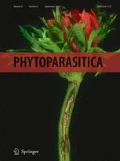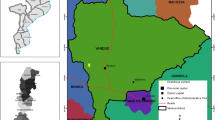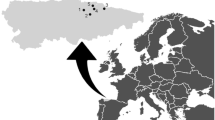Abstract
Bactrocera zonata is a devastating invasive pest of tropical and subtropical horticultural crops. Since its detection in Sudan in 2011, almost no information has emerged regarding its bio-ecology. This study aimed to determine the pest’s range and potential distribution in Sudan, it’s relative abundance, infestation level, associated indigenous natural enemies and assess their role in its natural control. The infestation levels of B. zonata and B. dorsalis were assessed in fruit orchards between 2014 and 2016. MaxEnt software was used to predict the distribution of both species countrywide using occurrence points. Out of eighteen states, B. zonata was recorded coexisting with B. dorsalis in nine states, with relative abundance ranging between 0.2–100%. This co-occurrence was also confirmed by MaxEnt that showed high climate suitability in these states, with the mean annual temperature being the most important variable affecting the distribution of both species. Fruits infested with B. zonata included mango, guava, grapefruit, oranges and papaya. Three parasitioids; Tetrastichus giffardianus, Agonaspis sp. and Psytallia sp. were found associated with B. zonata. Our results provide evidence that the pest is widely spread across the country and poses a significant threat of invasion into neighboring countries and beyond unless early detection and eradication programs are applied.




Similar content being viewed by others
References
Al-Eryan, M. A. S., El-Minshawy, A. M., & Awad, A. I. (2018). Suppression program of the peach fruit fly, Bactrocera zonata (Saunders) (Diptera: Tephritidae) depend on male annihilation and bait application techniques in northern coast of Egypt. Acta Scientific Agriculture, 2(8), 92–98.
Allwood, A. J., Chinajariyawong, A., Kritsaneepaiboon, S., Drew, R. A. I., Hamacek, E. L., Hancock, D. L., Hengsawad, C., Jipanin, J. C., Jirasurat, M., Krong, C. K., & Leong, C. T. S. (1999). Host plant records for fruit flies (Diptera: Tephritidae) in Southeast Asia. Raffles Bulletin of Zoology, 47, 1–92.
Amro, M. A., & Abdel-Galil, F. A. (2008). Infestation predisposition and relative susceptibility of certain edible fruit crops to the native and invading fruit flies (Diptera: Tephritidae) in the New Valley oases, Egypt. Assiut University bulletin for environmental researches, 11, 89–97.
Azrag, A. G., Pirk, C. W., Yusuf, A. A., Pinard, F., Niassy, S., Mosomtai, G., & Babin, R. (2018). Prediction of insect pest distribution as influenced by elevation: Combining field observations and temperature-dependent development models for the coffee stink bug, Antestiopsis thunbergii (Gmelin). PLoS One, 13, e0199569.
Bale, J. S., Masters, G. J., Hodkinson, I. D., Awmack, C., Bezemer, T. M., Brown, V. K., Butterfield, J., Buse, A., Coulson, J. C., Farrar, J., & Good, J. E. (2002). Herbivory in global climate change research: Direct effects of rising temperature on insect herbivores. Global Change Biology., 8, 1–16.
Bess, H. A. (1953). Status of Ceratitis capitata in Hawaii following the introduction of Dacus dorsalis and its parasites. Proceedings of the Hawaii Entomological Society, 15, 221–234.
Byeon, D. H., Jung, J. M., Lohumi, S., Cho, B. K., Jung, S., & Lee, W. H. (2017). Predictive analysis of Metcalfa pruinosa (Hemiptera: Flatidae) distribution in South Korea using CLIMEX software. Journal of Asia-Pacific Biodiversity, 10, 379–384.
Chidawanyika, F., Mudavanhu, P., & Nyamukondiwa, C. (2019). Global climate change as a driver of bottom-up and top-down factors in agricultural landscapes and the fate of host-parasitoid interactions. Parasitoids’ ecology and evolution. Frontiers in Ecology and Evolution, 7, 80. https://doi.org/10.3389/fevo.2019.00080.
Cugala, D.R., De Meyer, M., Canhanga, L. J. (2016) Integrated management of fruit flies–case studies from Mozambique, In S. Ekesi et al (eds), fruit fly research and development in Africa - towards a sustainable management strategy to improve horticulture. Springer International Publishing Switzerland, pp. 531–552.
Darwish, D. Y., Rizk, M. M., Abdel-Galil, F. A., & Temerak, S. A. (2014). Seasonal population trend of the peach fruit fly (PFF), Bactrocera zonata (Saunders) (Diptera: Tephritidae) in Assiut, northern upper Egypt. Archives of Phytopathology and Plant Protection, 47, 1158–1165.
De Meyer, M., Mohamed, S.A, White, I.M. (2007). Invasive fruit fly pests in Africa. 2007. Available onlin: http://www.africamuseum.be/fruitfly/AfroAsia.htm ().
De Villiers, M., Hattingh, V., Kriticos, D. J., Brunel, S., Vayssières, J. F., Sinzogan, A., Billah, M. K., Mohamed, S. A., Mwatawala, M., Abdelgader, H., Salah, F. E. E., & De Meyer, M. (2016). The potential distribution of Bactrocera dorsalis: Considering phenology and irrigation patterns. Bulletin Entomological Research, 106, 19–33.
Deng, A. L. (1990). Study on the behaviour, host range, seasonal abundance and chemical control of the Mediterranean fruit fly (Ceratitis capitata Wiedemann) in Sudan. M. Sc. Thesis, University of Khartoum, Sudan.
Drew, R.A., Romig, M.C. (2013). Tropical fruit flies (Tephritidae Dacinae) of South-East Asia: Indomalaya to north-West Australasia. CABI, Wallingford.
Drew, R.A.; Romig, M.C. (2016). Keys to the tropical fruit flies (Tephritidae: Dacinae) of South-East Asia: Indomalaya to north-West Australasia; CABI: Oxfordshire, UK,
Duyck, P. F., David, P., & Quilici, S. (2004). A review of relationships between interspecific competition and invasions in fruit flies (Diptera: Tephritidae). Ecological Entomology, 29, 511–520.
Duyck, P. F., David, P., & Quilici, S. (2006a). Climatic niche partitioning following successive invasions by fruit flies in La Réunion. Journal of Animal Ecology, 75, 518–526.
Efflatoun, H. C. (1924). A monograph of Egyptian Diptera, part II., Fam. Trypaneidae. Mémoires Society Entomology Egypte., 2, 1–132.
Ekesi, S., Billah, M. K., Nderitu, P. W., Lux, S. A., & Rwomushana, I. (2009). Evidence for competitive displacement of Ceratitis cosyra by the invasive fruit fly Bactrocera invadens (Diptera: Tephritidae) on mango and mechanisms contributing to the displacement. Journal of Economic Entomology, 102, 981–991.
El-Samea, S. A. A., & Fetoh, B. E. A. (2006). New record of Bactrocera zonata (Saunders) (Diptera: Tephritidae) on potatoes in Egypt. Egyptian Journal of Agricultural Research, 84, 61–63.
EPPO (2002) Introduction of Bactrocera zonata into the EPPO region (situation in 2002). Bactrocera zonata: introduction into the EPPO region and its identification by Dr Ian M. White EPPO Workshop on Bactrocera zonata; Paris, 5–6 March 2002. https://www.eppo.int/ACTIVITIES/plant_quarantine/shortnotes_qps/bactrocera_zonata. Accessed 19 March 2020.
EPPO. (2010). Bactrocerazonata: Procedure for official control. Bulletin OEPP/EPPO Bulletin, 40, 390–395.
EPPO. (2013). PM 7/114 (1) Bactrocera zonata. Bulletin OEPP/EPPO Bulletin., 43, 412–416.
EPPO. (2005). Bactrocera zonata. Bulletin OEPP/EPPO Bulletin, 35, 371–373.
Foote, R. H., Blanc, F. L., & Norrbom, A. L. (1993). Handbook of the fruit flies (Diptera: Tephritidae) of America north of Mexico. Ithaca, USA: Comstock.
Ghanim, N. M., Moustafa, S. A., El-Metwally, M. M., Afia, Y. E., Salman, M. S., & Mostafa, M. E. (2010). Efficiency of some insecticides in male annihilation technique of peach fruit fly, Bactrocera zonata (Saunders) under Egyptian conditions. Egyptian Academic Journal of Biological Sciences, F. Toxicology and Pest Control, 2, 13–19.
Goergen, G., Vayssières, J. F., Gnanvossou, D., & Tindo, M. (2011). Bactrocera invadens (Diptera: Tephritidae), a new invasive fruit fly pest for the Afrotropical region: Host plant range and distribution in west and Central Africa. Environmental Entomology, 40, 844–854.
IAEA (2003). Trapping Guidelines for Area-Wide Fruit Fly Programmes. International Atomic Energy Agency, Vienna, Austria.2003. Available onlin at http://www-naweb.iaea.org/nafa/ipc/public/Trapping-guideline-(002).pdf (accessed on 22 August 2019).
IFAD (2012). Supporting the small-scale traditional rain fed producers in Sinnar state (SUSTAIN) design report: Main report and annexes near east and North Africa division programme management department. Republic of the Sudan. URL:https://www.ifad.org/documents/10180/d90ce55a-719d-41cf-bb02-2925d5809050 (accessed on 22 August 2019).
Kapoor, V.C. (1993). Indian fruit flies (Insecta: Diptera: Tephritidae). Oxford and IBH Publishing Company, New Delhi.
Kriticos, D. J., Maywald, G. F., Yonow, T., Zurcher, E. J., Herrmann, N. I., & Sutherst, R. (2015). Exploring the effects of climate on plants, animals and diseases. CLIMEX Version, 4, 184.
LaSalle, J., & Wharton, R. A. (2002). The identity and recognition of African Tetrastichus species (Hymenoptera: Eulophidae) associated with fruit flies (Diptera: Tephritidae). African entomology, 10(2), 297–304.
Lux, S. A., Copeland, R. S., White, I. M., Manrakhan, A., & Billah, M. K. (2003). A new invasive fruit fly species from the Bactrocera dorsalis (Hendel) group detected in East Africa. International Journal of Tropical Insect Science, 23, 355–361.
Mohamed, S.A., Ramadan, M.M., & Ekesi S. (2016). In and out of Africa: Parasitoids used for biological control of fruit flies. In S. Ekesi et al (eds), fruit fly research and development in Africa - towards a sustainable management strategy to improve horticulture. Springer International Publishing Switzerland; pp. 325–368.
Mosleh, Y.Y., Moussa, S.F.M; Mohamed, L.H.Y. (2011). Comparative toxicity of certain pesticides to peach fruit fly, Bactrocera zonata Saunders (Diptera: Tephritidae) under laboratory conditions. Plant Protection Science, 47, 115–120.
Mwatawala, M., De Meyer, M., White, I. M., Maerere, A., & Makundi, R. H. (2007). Detection of the solanum fruit fly, Bactrocera latifrons (Hendel) in Tanzania (Dipt., Tephritidae). Journal of Applied Entomology, 131, 501–503.
Mwatawala, M. W., De Meyer, M., Makundi, R. H., & Maerere, A. P. (2009). An overview of Bactrocera (Diptera: Tephritidae) invasions and their speculated dominancy over native fruit fly species in Tanzania. Journal of Entomology, 6, 18–27.
Ni, W. L., Li, Z. H., Chen, H. J., Wan, F. H., Qu, W. W., Zhang, Z., & Kriticos, D. J. (2012). Including climate change in pest risk assessment: The peach fruit fly, Bactrocera zonata (Diptera: Tephritidae). Bulletin of Entomological Research, 102, 173–183.
Phillips, S. J., Anderson, R. P., & Schapire, R. E. (2006). Maximum entropy modeling of species geographic distributions. Ecological Modelling, 190, 231–259.
Quilici, S. P., Rousse, J.P., Deguine, C., Simiand, A., Franck, F., Gourdon, T., & Harris, E.J. (2008). Successful acclimatization of the ovo-pupal parasitoid Fopius arisanus in Réunion island for the biological control of the Peach fruit fly, Bactrocera zonata. In Communication presented at the 1st Meeting of TEAM. Tephritid Workers of Europe Africa and the Middle East, pp. 7–8.
Qureshi, Z. A., Hussain, T., & Siddiqui, Q. H. (1991). Relative preference of mango varieties by Dacus zonatus (Saunders) and D. dorsalis Hendel. Pakistan Journal of Zoology, 23, 85–87.
R Core Team (2017). A language and environment for statistical computing. R Foundation for statistical computing, Vienna, Austria. Available onlinee at https://www.R-project.org/.
Rauf, I., Ahmad, N., Rashdi, S. M. S., Ismail, M., & Khan, M. H. (2013). Laboratory studies on ovipositional preference of the peach fruit fly Bactrocera zonata (Saunders) (Diptera: Tephiritidae) for different host fruits. African Journal of Agricultural Research, 8, 1300–1303.
Rizk, M. M., Abdel-Galil, F. A., Temerak, S. A., & Darwish, D. Y. (2014). Relative preference of peach fruit fly, Bactrocera zonata (Saunders) (Diptera: Tephritidae) to some fruit and vegetables under laboratory conditions. Archives of Phytopathology and Plant Protection, 47, 1376–1380.
Rousse, P., Gourdon, F., & Quilici, S. (2006). Host specificity of the egg pupal parasitoid Fopius arisanus (Hymenoptera: Braconidae) in La Reunion. Biological Control, 37, 284–290.
Rwomushana, I., Ekesi, S., Ogol, C. K., & Gordon, I. (2009). Mechanisms contributing to the competitive success of the invasive fruit fly Bactrocera invadens over the indigenous mango fruit fly, Ceratitis cosyra: The role of temperature and resource pre-emption. Entomologia Experimentalis et Applicata, 133, 27–37.
Salah, F.E.E., Abdelgader, H., De Villiers, M. (2012). The occurrence of the peach fruit fly, Bactrocera zonata (Saunders) (Tephritidae) in Sudan. In TEAM 2nd International Meeting: Biological Invasions of Tephritidae: Ecological and Economic Impact. Kolymbari Crete.
Sarwar, M., Ahmad, N., Rashid, A., & Shah, S. M. M. (2015). Valuation of gamma irradiation for proficient production of parasitoids (Hymenoptera: Chalcididae and Eucoilidae) in the management of the peach fruit-fly, Bactrocera zonata (Saunders). International journal of pest management, 61, 126–134.
Sarwar, M., Hamed, M., Rasool, B., Yousaf, M., & Hussain, M. (2013). Host preference and performance of fruit flies Bactrocera zonata (Saunders) and Bactrocera cucurbitae (Coquillett) (Diptera: Tephritidae) for various fruits and vegetables. International Journal of Scientific Research Environmental Science, 1, 188–194.
Sarwar, M., Hamed, M., Yousaf, M., & Hussain, M. (2014). Monitoring of population density and fruit infestation intensity of tephritid fruit flies (Diptera: Tephritidae) in Citrus reticulata Blanco orchard. Journal of Zoological Science., 2, 1–5.
Shehata, N. F., Younes, M. W., & Mahmoud, Y. A. (2008). Biological studies on the peach fruit fly, Bactrocera zonata (Saunders) in Egyptian. Journal of Applied Science and Research, 4, 1103–1106.
Spaugy, L. (1988). Fruit flies: Two more eradication projects over. Citrograph, 73, 168.
Steck, G.J. (2010). A peach fruit fly, Bactrocera zonata (Saunders)(Tephritidae). Florida Department of Agriculture and Consumer Service, Available online: http://www.freshfromflorida.com/content/download/65230/1532266/PESTALERTPeachFruit_Fly_Bactrocera_Zonata.pdf (accessed on 22 August 2019).
Stephens, A. E. A., Kriticos, D. J., & Leriche, A. (2007). The current and future potential geographical distribution of the oriental fruit fly, Bactrocera dorsalis (Diptera: Tephritidae). Bulletin of Entomological Research., 97, 369–378.
Stibick, J.N. (2004). Natural enemies of true fruit flies (Tephritidae) (p. 86). United States Department of Agriculture, Animal and Plant Health Inspection Serv.
Van Zwaluwenberg, R. H. (1947). Notes and exhibitions. Proceedings of the Hawaii Entomological Society, 13, 8.
Vera, M. T., Rodriguez, R., Segura, D. F., Cladera, J. L., & Sutherst, R. W. (2002). Potential geographical distribution of the Mediterranean fruit fly, Ceratitis capitata (Diptera: Tephritidae), with emphasis on Argentina and Australia. Environmental Entomology, 31, 1009–1022.
Virgilio, M., White, I., & De Meyer, M. (2014). Set of multi-entry identification keys to African frugivorous flies (Diptera, Tephritidae). ZooKeys, 428, 97–108.
Wharton, RA., Yoder, MJ. (2020). Parasitoids of fruit-infesting Tephritidae. http://paroffit.org. Accessed on Thu mar 19 11:13:08 -0500 2020.
White, I. M. (2006). Taxonomy of the Dacina (Diptera:Tephritidae) of Africa and the Middle East. African Entomology, 2, 1–156.
White, I.M., De Meyer, M.D., Stonehouse, J. (2000). A review of native and introduced fruit flies (Diptera, Tephritidae) in the Indian Ocean islands of Mauritius, Réunion, Rodrigues and Seychelles. In Proceedings of the Indian Ocean Commission, Regional Fruit Fly Symposium, Flic en Flac, Mauritius, 5th-9th June. Pp. 15-21.
White, I.M, Elson-Harris, M.M. (1994). Fruit flies of economic significance: Their identification and bionomics. CAB International: Wallingford, UK.
Zhang, W., Ricketts, T. H., Kremen, C., Carney, K., & Swinton, S. M. (2007). Ecosystem services and dis-services to agriculture. Ecological Economics, 64, 253–260. https://doi.org/10.1016/j.ecolecon.2007.02.024.
Acknowledgments
Authors would like to thank the staff of the Agricultural Research Corporation at all stations in Sudan for Technical and kind support in the Laboratory and field.
Funding
This research was funded by the Department for International Development (DFID), through the program “Support to International Agricultural Research Centres ARIES Code 202748. Additional support was obtained from icipe’s institutional funding from the UK’s Department for International Development (DFID), the Swedish International Development Cooperation Agency (SIDA), the Swiss Agency for Development and Cooperation (SDC), and the Kenyan Government.
Author information
Authors and Affiliations
Contributions
The work was conceptualized by: [Mohammedelnazeir Elfadil Mahmoud, Samira Abuelgasim Mohamed and Sunday Ekesi]; methodology: [Mohammedelnazeir Elfadil Mahmoud and Samira Abuelgasim Mohamed]; software: [Abdelmutalab G. A. Azrag]; validation: [Mohammedelnazeir Elfadil Mahmoud, Samira Abuelgasim Mohamed, Abdelmutalab G. A. Azrag and Shepard Ndlela]; formal analysis: [Shepard Ndlela, Abdelmutalab G. A. Azrag, Samira Abuelgasim Mohamed and Mohammedelnazeir Elfadil Mahmoud]; investigation: Mohammedelnazeir Elfadil Mahmoud, Mohamed A. E. Bashir]; resources: [Samira Abuelgasim Mohamed and Sunday Ekesi] data curation: [Mohammedelnazeir Elfadil Mahmoud, Samira Abuelgasim Mohamed and Shepard Ndlela]; writing—original draft preparation: [Mohammedelnazeir Elfadil Mahmoud, Samira Abuelgasim Mohamed, Samira Abuelgasim Mohamed, Abdelmutalab G. A. Azrag and Shepard Ndlela]; writing—review and editing: [Shepard Ndlela, Abdelmutalab G. A. Azrag, Samira Abuelgasim Mohamed and Shepard Ndlela]; supervision: [Samira Abuelgasim Mohamed and Fathiya M. Khamis]; project administration: [Samira Abuelgasim Mohamed]; funding acquisition: [Samira Abuelgasim Mohamed and Sunday Ekesi].
Corresponding authors
Ethics declarations
Conflict of interest
The authors declare no conflict of interest. The funders had no role in the design of the study; in the collection, analyses, or interpretation of data; in the writing of the manuscript, or in the decision to publish the results.
Additional information
Publisher’s note
Springer Nature remains neutral with regard to jurisdictional claims in published maps and institutional affiliations.
Rights and permissions
About this article
Cite this article
Mahmoud, M.E.E., Mohamed, S.A., Ndlela, S. et al. Distribution, relative abundance, and level of infestation of the invasive peach fruit fly Bactrocera zonata (Saunders) (Diptera: Tephritidae) and its associated natural enemies in Sudan. Phytoparasitica 48, 589–605 (2020). https://doi.org/10.1007/s12600-020-00829-0
Received:
Accepted:
Published:
Issue Date:
DOI: https://doi.org/10.1007/s12600-020-00829-0




